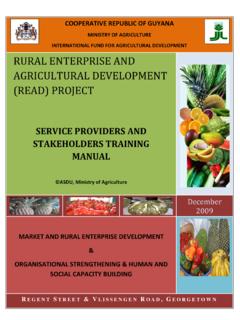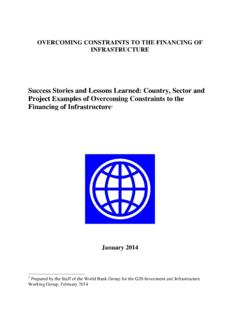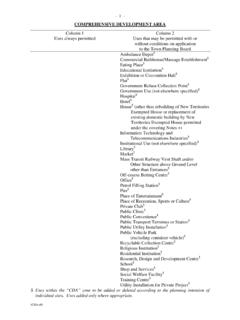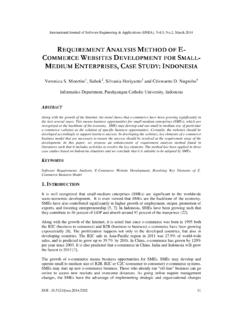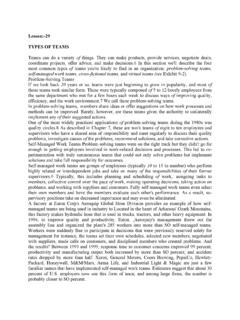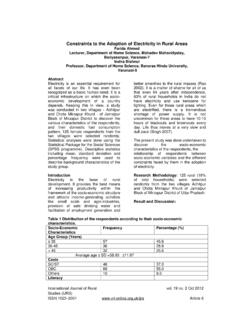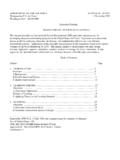Transcription of CONSTRAINTS AND OPPO RTUNITIES FOR …
1 SUMMARY | APRIL 2010. Pulses Value Chain in Ethiopia CONSTRAINTS AND OPPORTUNITIES FOR enhancing EXPORTS. WORKING PAPER | July 2010. WITH SIGNIFICANT CONTRIBUTIONS FROM SHAHIDUR RASHID ,CHILOT YIRGA , BEFEKADU BEHUTE, AND SOLOMON LEMMA. TABLE OF CONTENTS. Executive Summary .. 2. Pulses in Ethiopian Agriculture .. 2. The Potential of a Vibrant Pulses Sector .. 2. Challenges in the 2. Recommendations .. 3. The Way Forward .. 4. Acknowledgements .. 5. Acronyms .. 6. Background .. 6. Methodology of Diagnostic Work .. 7. Introduction .. 8. Characterization of pulses subsector .. 9. Overview .. 9. Recent growth of pulses subsector .. 13. Public policies .. 17. Contributions of pulses to smallholders' livelihood .. 18. Results of Value-chain Analyses .. 20. Production .. 20. Product aggregation and trading .. 22. Commercialization/ export .. 25. Recommendations .. 30. Strengthening the export 30. Increasing linkage between exporters and producers.
2 32. Increasing inputs to improve 33. 34. Conclusion .. 36. Overview .. 36. Five-year sectoral vision .. 36. The way forward .. 36. Appendix 1: References and 37. Appendix 2: Global Pulse Production .. 40. Appendix 3: Volume and Value of Pulse Exports by Exporter 41. Appendix 4: Producer Prices Ranked by Total Production .. 42. 1. EXECUTIVE SUMMARY. PULSES IN ETHIOPIAN AGRICULTURE SUMMARY | APRIL. This report provides an analysis of the critical role of pulses in agricultural production as a driver for economic growth and food security. Pulses, which occupy approximately 13 percent of cultivated land and account for approximately 10 percent of the agricultural value addition, are critical to smallholder livelihoods in Ethiopia. Pulses contribute to smallholder income, as a higher-value crop than cereals, and to diet, as a cost-effective source of protein that accounts for approximately 15 percent of protein intake.
3 Moreo- ver, pulses offer natural soil maintenance benefits through nitrogen-fixing, which improves yields of cereals through crop rotation, and can also result in savings for smallholder farmers from less fertilizer use. Pulses also contribute significantly to Ethiopia's balance of payments. They are the third-largest export crop after coffee and sesame, contributing USD 90 million to export earnings in 2007/08. THE POTENTIAL OF A VIBRANT PULSES SECTOR. Through productivity and market improvements, the critical role of pulses in smallholder livelihood and food security can be expanded. The current productivity of pulses falls significantly below the demon- 1. strated potential. For example, current average chickpea yields are metric tons per hectare but the demonstrated potential in Ethiopia is tons per hectare if accompanied by the appropriate inputs. Estimates suggest that productivity gains from improvements in planting techniques could double overall pulse production to two million tons over a period of five years.
4 This gain in productivity would not only increase smallholder income by 40 to 70 percent per hectare, but would also ensure greater food security through meeting domestic pulse demand. In addition, Ethiopia could expand its foreign market presence through increased production le- vels, which will lead to at least doubling of its current annual exports of about 140,000 tons. Even under conservative assumption of proportionate increase in domestic consumption and export , doubling production will result in at least doubling of export earnings from US$90 million to US$180. If the domestic production remains at the current level, export earnings will be far greater. CHALLENGES IN THE VALUE CHAIN. However, a set of CONSTRAINTS span the pulses value-chain in production, aggregation and trading, and demand sinks/ export . High-level findings are presented below: Production. Productivity is below potential due to: low input usage, especially chemical fertiliz- ers capable of increasing yields in field trials by 10 to 80 percent; limited availability of seed and limited familiarity with the variety of existing pulse types, and; limited usage of modern agro- nomic and trading.
5 The link between the producers and the export markets is weak, due to the large number of ineffective intermediaries operating in the value chain. The intermediaries have failed to acquire scale and operate in limited geographic areas. The fragmentation of intermediaries between the producer and consumer markets creates a lack of transparency in markets. export . While there has been substantial growth in recent years, the current export market is underdeveloped. The less developed, fragmented exporters operating at smaller scale in the market results in inconsistent export flows and thus, inconsistent demand for exports. The ma- jor causes of limited export development are (i) inadequate market intelligence (ii) inability to leverage scale efficiencies due to smaller size and (iii) non-conducive the business environ- ment due to missing credit and insurance; and (iv) inconsistent policy interventions.
6 1 This yield is substantially higher than the world average and sub-Saharan African averages of tons/ha 2. RECOMMENDATIONS. Core interventions and enabling actions can holistically strengthen the Ethiopian pulses value chain to be productive and stable, and provide year round transactions that supply domestic and international SUMMARY | APRIL. markets. These recommendations are complementary to and intended to accelerate the impact of current GOE and development partner strategies: Increase inputs to improve productivity. Access to inputs is a key step in bridging the yield gap between current and potential production. Phosphates and other fertilizers should be sup- plied to farmers, along with knowledge on how to use them effectively. Seed multiplication should be increased to adequately supply the needs of exporters and domestic demand. Pulse breeding should expand, and leverage varietals used in other countries.
7 Extension should in- corporate pulses into the curriculum. Enhance linkages between exporters and producers. Stronger linkages between exporters and smallholders will lead to a more efficient value chain where demand signals are clearly communicated to the producers, and where inputs are available to ensure proper production of the necessary export pulses. Actions to enable consistent supply between producers and ex- porters may include: provision of regional-specific input packages; development of new varie- ties appropriate for export ; leverage of cooperatives to provide consistent input supply and off- take. Provide adequate market to the exporters and farmers. ECX will play an important role in market transparency, quality, and aggregation for exports. However, exporters association and other relevant agencies assume the responsibility of tracking both domestic and international markets Strengthen the export sector.
8 Developing the export sector will drive foreign reserve earnings and will create a steady demand pull for pulses, thereby acting as a catalyst for the sector. Ex- porters should be supported through a business environment more conducive to investment and policies aimed at bolstering exporters' scale, knowledge base, as well as business acu- men. However, realizing the potential of the pulses value chain cannot be done in isolation; it can only work if other components of the agriculture system are in place: extension, improved seed, and soil fertility measures. This report shows how Ethiopia can chart a practical path of initiatives to realize the potential in the pulses value chain, while increasing incomes of its small holder farmers and delivering on food security objectives. 3. THE WAY FORWARD. With a clear, fact-based vision for the aspiration, a credible plan of action, and the support of an effective performance management process, Ethiopia will be in a strong position to mobilize the SUMMARY | APRIL.
9 Resources needed to deliver on these CONSTRAINTS . Ethiopia can convert this potential into critical improvements in food security and livelihood for the country. The recommendations of this report offer a first view on how Ethiopia can chart a practical path of initiatives to achieve these goals. Implementing the recommendations outlined in this report will require human and financial re- sources. They will also require a level of sequencing and coordination that have in the past been challenging to implement at a national and regional level. To achieve these objectives, the GOE will need to work closely with all its partners (donors and development community, NGOs, cooperatives and unions, public and international research organizations, private sector and the various organiza- tions working directly with farmers at the local level). This report provides a preliminary view on the sequencing of various activities to strengthen the pulses value chain.
10 A preliminary view of the sequencing of activities that could strengthen the maize value chain follows: Figure 1: Overview of recommendations and activity sequencing Long-term Short medium term (3-5 years). (1-2 years). Develop incentives for exporters to invest Strengthen export promotion, Strengthen resources to link with input supply bodies market intelligence, and the branding export Build export trader association to build of Ethiopian products Sector markets, regulate quality and help achieve scale - Develop a business environment conducive to investment, and policies to scale exporters - Supply smallholders with input supply Improve access to markets packages, consistent off-take, and market through road networks and storage Increase information facilities export / - Link smallholders with agribusiness producer enterprises through contract farming; put linkages mechanisms in place for quality control - Improve on-farm storage management practices and structures - Source phosphate and other fertilizers, - Increase breeding of pulse and train smallholders on their use varietals Increase - Increase breeding of pulse varietals - Increase seed multiplication in inputs - Increase seed multiplication in order to order to meet needs of export and meet needs of export and domestic demand domestic demand - Incorporate pulses into the extension curriculum 4.











